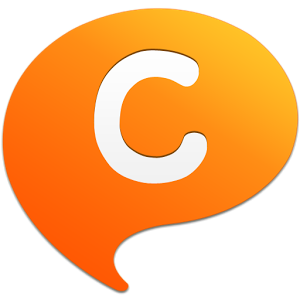
Google Talk was an instant messaging service that provided both text and voice communication. The instant messaging service was variously referred to colloquially as Gchat, Gtalk, or Gmessage among its users.
A voice-user interface (VUI) enables spoken human interaction with computers, using speech recognition to understand spoken commands and answer questions, and typically text to speech to play a reply. A voice command device is a device controlled with a voice user interface.

Android 13 is the thirteenth major release and the 20th version of Android, the mobile operating system developed by the Open Handset Alliance led by Google. It was released to the public and the Android Open Source Project (AOSP) on August 15, 2022. The first devices to ship with Android 13 were the Pixel 7 and 7 Pro.

Bing for mobile is a search tool for handheld mobile devices from Microsoft as part of their Bing search engine. It is designed for mobile device displays. Bing Mobile is built into Windows Mobile and Windows Phone as proprietary software, accessed via the Search key on Windows Phone 7 and Windows Phone 8 devices. It is also available on Windows Phone 8.1, and can be downloaded for other platforms, including and Android.

Google Voice is a telephone service that provides a U.S. phone number to Google Account customers in the U.S. and Google Workspace customers in Canada, Denmark, France, the Netherlands, Portugal, Spain, Sweden, Switzerland, the United Kingdom and the contiguous United States. It is used for call forwarding and voicemail services, voice and text messaging, as well as U.S. and international calls. Calls are forwarded to the phone number that each user must configure in the account web portal. Users can answer and receive calls on any of the phones configured to ring in the web portal. While answering a call, the user can switch between the configured phones. Subscribers in the United States can make outgoing calls to domestic and international destinations. The service is configured and maintained by users in a web-based application, similar in style to Google's email service Gmail, or Android and iOS applications on smartphones or tablets.
Android is a mobile operating system based on a modified version of the Linux kernel and other open-source software, designed primarily for touchscreen mobile devices such as smartphones and tablets. Android is developed by a consortium of developers known as the Open Handset Alliance, though its most widely used version is primarily developed by Google. It was unveiled in November 2007, with the first commercial Android device, the HTC Dream, being launched in September 2008.

Windows Phone (WP) is a discontinued mobile operating system developed by Microsoft for smartphones as the replacement successor to Windows Mobile and Zune. Windows Phone featured a new user interface derived from the Metro design language. Unlike Windows Mobile, it was primarily aimed at the consumer market rather than the enterprise market.

BBM, also known by its full name BlackBerry Messenger, was a consumer-oriented proprietary mobile instant messenger and videotelephony application service originally developed by BlackBerry Limited and later briefly by Indonesian company Emtek under licence. Initially it was included and offered on BlackBerry devices before it was expanded cross-platform. BBM was shut down on 31 May 2019; the company since continues to offer the paid enterprise edition, BBM Enterprise.
Google Goggles was an image recognition mobile app developed by Google. It was used for searches based on pictures taken by handheld devices. For example, taking a picture of a famous landmark searches for information about it, or taking a picture of a product's barcode would search for information on the product.

Siri is the digital assistant that is part of Apple Inc.'s iOS, iPadOS, watchOS, macOS, tvOS, audioOS, and visionOS operating systems. It uses voice queries, gesture based control, focus-tracking and a natural-language user interface to answer questions, make recommendations, and perform actions by delegating requests to a set of Internet services. With continued use, it adapts to users' individual language usages, searches, and preferences, returning individualized results.
Telenav, Inc. is a wireless location-based services corporation that provides services including Global Positioning System (GPS) satellite navigation, local search, automotive navigation solutions, mobile advertising, enterprise mobility and workflow automation. The company’s headquarters are located in Santa Clara, California in the United States with additional offices in the U.S., Germany, Japan, Romania, China, and Brazil.
Vlingo was a speech recognition software company co-founded by speech-to-text pioneers Mike Phillips and John Nguyen in 2006. It was best known for its intelligent personal assistant and knowledge navigator, also named Vlingo, which functioned as a personal assistant application for Symbian, Android, iPhone, BlackBerry, and other smartphones. Vlingo was acquired by speech recognition giant Nuance Communications in 2012.

ChatON was a global mobile communication service provided by Samsung Electronics from September 2011 to March 2015.

Google Now was a feature of Google Search of the Google app for Android and iOS. Google Now proactively delivered information to users to predict information they might need in the form of informational cards. Google Now branding is no longer used, but the functionality continues in the Google app and its discover tab.

Cortana is a discontinued virtual assistant developed by Microsoft that used the Bing search engine to perform tasks such as setting reminders and answering questions for users.

Gboard is a virtual keyboard app developed by Google for Android and iOS devices. It was first released on iOS in May 2016, followed by a release on Android in December 2016, debuting as a major update to the already-established Google Keyboard app on Android.

The Google Assistant is a virtual assistant software application developed by Google that is primarily available on mobile and home automation devices. Based on artificial intelligence, The Google Assistant can engage in two-way conversations, unlike the company's previous virtual assistant, Google Now.
Petal Search is a mobile Search-based application for Android, owned and operated by Huawei and aimed at allowing users to find apps and web results delivered by Microsoft Bing. It originally had an independent search engine under the same name available on the web, but it was quietly discontinued on June 25th, 2023. The Petal suite of search, mail, and maps were created in response to sanctions that barred Huawei from using Google Mobile Services. The engine provides comprehensive search functionality including text, voice, visual, news, video, app, shopping, travel, and local searches. It can present mobile app results from the Huawei AppGallery and other trusted app stores. Petal's design, which includes a dark mode, is based on a mobile-first approach. Launched globally, the service is especially focused on European markets and supports 55 languages in 170 countries and regions as of November 2021. The Petal Search app is available in the Huawei AppGallery and the Apple App Store.











